The steam room assumes a significant heating of the body - soaring. For this, steam must be obtained in a confined space. One way to do this is to organize your own steam generator.
Types of baths
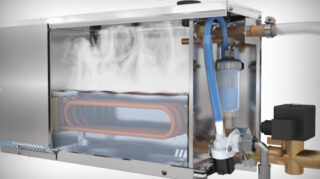
Steam is generated by the evaporation of water. Get it in a variety of ways. The efficiency of steaming and the bathing procedure itself depends on what kind of steam is produced, what temperature is maintained and how it is maintained. There are 3 options for a steam bath.
- Sweat - sweating. Here a person "washes" with his own sweat. In a Finnish sauna, sweating is achieved with a high temperature, in a Russian sauna - with a relatively high temperature and whipping with a broom, in a hammam - with high humidity. The steam room is not needed in the sweating room.
- Steam room - condensation from high-humidity air forms on human skin. Steam is obtained here by pouring water or kvass on hot stones.
- Shaychnaya - the steamed one is washed with warm water from numerous basins, shanks, barrels by splashing and pouring. It differs from a shower or a bath in its short-lived interaction with water. The main condition of the pelvic is that the temperature is high enough so that after dousing the person does not feel cold.
The need for steam generation appears in traditional Russian steam rooms and their analogues.
Steam features

Sauna masters distinguish between many types of steam. Depending on the temperature conditions in the steam room from floor to ceiling, several steam-air mixtures are formed.
The steam plant in the bath can generate the following types of steam.
- Scalding - oversaturated steam. Forms hot dew on the skin and then turns into a rich one. Such steam burns lips and mouth at the entrance and is "visible" as clouds of fog.
- Light - overheated but not saturated. It cools down around the person, and only after reaching the point of condensation, it forms dew on the skin. It does not burn - it tingles the ears, transfers heat deep into the nasopharynx and even the bronchi and is considered the most useful in the treatment of diseases of the respiratory system. Steam is not visible.
- Wet - Contains water droplets or mist. Usually obtained by explosive evaporation of water on a large-textured surface. In this case, the water does not evaporate completely and forms separate drops. It is not very pleasant, as it creates a contrast between pleasant fine steam and large, highly heated droplets.
In order to prevent the receipt of wet steam, spray traps are often mounted on the heater. They allow evaporated water to pass through, but retains drops.
Differences between steam generator and steam gun
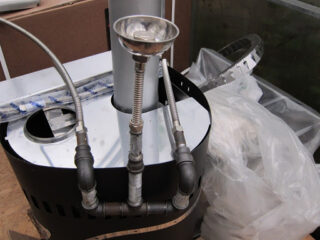
The traditional method of generating steam is a heater. However, using it requires some experience and skill. Otherwise, it will be difficult to achieve light steam. Special devices - a steam gun and a steam generator for a bath - do the job better.
What is a steam cannon
The heater heats up the most at the bottom, while the water splashes on the top. Because of this, you either have to heat the stones much more strongly, or be content with not very good steam.
The steam cannon is a design that allows water to be delivered directly to the lower stones. It is a thick-walled tube with holes, which is placed at the bottom of the heater.The second part of the pipe is fixed perpendicularly and equipped with a funnel. Pour water into it. The water flows into the lower part of the stove and comes into contact with the hottest stones. This is how light steam is obtained.
Minus: while the steam reaches the upper stones, it partially cools down. Therefore, sometimes a steam outlet is installed, which removes steam through a separate channel.
How does a steam generator work
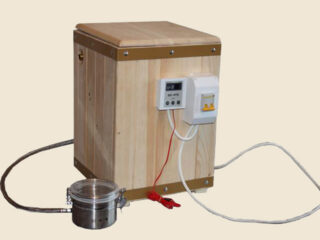
A steam generator is an electrical device that has nothing to do with the stove. Works like a kettle, but does not turn off when the water reaches the boiling point. The steam generator is equipped with a valve and a valve, the body is sealed. This makes it possible to obtain finely dispersed superheated steam without droplets.
There are several types of device:
- electrode - water is heated by electrodes;
- induction - a circuit through which water circulates, heats up due to self-induction currents;
- Heating element - analogue of an electric kettle or boiler;
- stove - the camera is mounted in the firebox of the stove, where it is heated by an open fire.
You can make a stove and heating element with your own hands.
What to choose for a bath
It is necessary to choose a means for obtaining steam, taking into account the nature of the bath.
- The Finnish sauna has a high temperature - up to +120 C, and a low humidity - 15%. Such heat with high humidity is very difficult to tolerate, so it is important to get superheated steam in small portions. A steam cannon with a steam pipe is much more suitable for this role.
- In the steam room, the temperature rises no more than +80 C, but the humidity is higher - up to 70-80%. Here steam is needed, and in different quantities, depending on the nature of the procedure. It is much more convenient to use an independent device - a steam generator. However, it is very important to select it according to its performance, since a lot of steam is needed.
- The hamam assumes a very high humidity - up to 100%, but a low temperature - no more than +45 C. Here you can easily do without both devices, since steam is needed just wet, heavy - damp. If the need arises for heated steam, a steam generator is installed.
Additional alternative devices are selected taking into account the power and design of the heater.
Steam generator manufacturing
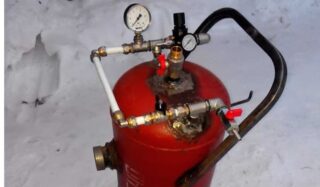
The easiest way is to make a do-it-yourself stove steam generator. For this, cavities are welded on the inner wall of the furnace. Water is poured into them through a watering can, and steam is removed using a steam outlet. Only saturated steam is obtained in this way, most often raw. But since it is mixed with a large volume of heated air and steam from the stove, the result is quite decent.
With some skill, you can make an electric steam generator for the bath with your own hands. For such a model you will need:
- gas cylinder with a volume of 27 liters;
- TEN or other tubular heaters;
- paronite gaskets, safety valve, faucet and ball valve;
- corrugated metal hose or pipe;
- pressure gauge;
- welding machine;
- grinder, drill, keys.
You will also need a variety of fittings and gaskets: squeegees, couplings, fum tape.
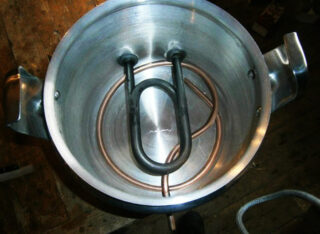
Work begins with the preparation of materials. The gas cylinder is emptied, the valve is turned off and the gas condensate is drained. Then the container is filled with water so that the liquid displaces the remaining gas.
- Cut off the top of the cylinder along the weld. The inside is washed with detergents.
- In the lower part, at a distance of 1 cm from the bottom, holes are drilled for the heating element - the same diameter. Install heating elements so that they do not touch, and seal with gaskets.
- At a height of 10 cm from the bottom, a pipe for water supply is cut into the container. A heat-resistant hose is placed on it and lowered into a transparent container: this vessel will be used to determine the water level in the apparatus.
- A pressure gauge and a safety valve are attached to the cut off cover. It is better to choose a device with an electric relay that can turn off the heating elements when a certain pressure is reached.
- A steam line is connected to the valve with a throttling element.This role is played by a 50 cm fragment of a steel pipe with holes 2-3 mm in diameter. The element allows steam to escape slightly so that the latter does not escape from the hose under too high pressure.
- The electric heater housing is equipped with a U-lock. A rubber seal is placed in its recess.
- L-shaped iron studs with a diameter of 10 mm and nuts by 12 mm are welded to the walls of the cylinder and to the side parts of the roof.
- Put all the generator parts together.
It is not recommended to join all parts by welding. In this case, the heating element for repair will have to be cut off with a grinder.
How to make a steam cannon in a bath
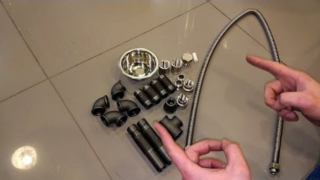
A steam cannon for a sauna stove with your own hands is made even faster. Required:
- funnel made of stainless steel;
- corrugated pipe 2.5 m long;
- tee, transition angle, connector (barrel) ½ inch;
- fittings for connection;
- check valve;
- hacksaw for metal, scissors;
- welding machine;
- electric drill with drills with a diameter of 2 to 5 mm;
- keys.
The check valve can be made by yourself. It will need a steel sheet 10 * 10 cm and a spring wire.
Mount the evaporator using the step-by-step guide.
- From corners, tees and connectors, a structure of the desired configuration is mounted. The scheme of the latter is chosen depending on the volume and shape of the heater.
- A piece of corrugated pipe 50–100 cm long is cut off and connected with a corner to a fitting.
- A check valve and a threaded fitting are mounted and connected to a corrugated pipe for water supply. Instead of corrugated, you can take a regular tap, but then you need to cut the threads along the edges.
- In the horizontal part of the device, which will supply water to the stones, holes with diameters of 1–3 mm are drilled. The distance between them is up to 5 cm.
- The steam cannon is placed on the bottom of the net and filled with stones. The watering can remain above the level of the slide.
Test the device with a small amount of liquid while heating the oven at half power. If the test is successful, retest at full power.
The advantages of a steam cannon of complex design

The scheme of a complicated steam cannon for a do-it-yourself bath includes several improvements. They produce higher quality steam.
The vertical part of the structure has a minimum area. The pipes do not get hot as the bottom of the stove heats up, so it is important to bring the water to the horizontal part as quickly as possible.
Any device that allows boiling water to be poured into the funnel improves the quality of steam.
An important element is the shut-off valve. In its absence, part of the steam under pressure will come out back from the watering can, moreover, it will cool on the walls of the device. This steam will be heavier. The shut-off valve prevents steam from escaping back. Under pressure, it breaks out of small holes and repeatedly breaks against stones in the grid. This is how finely dispersed steam is obtained.
If the steam cannon is installed on an ordinary wood-burning stove, and not on a heater, it must be supplemented with a splash guard.








